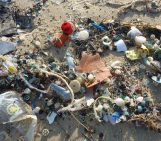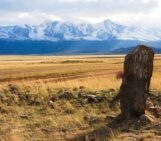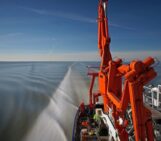Earlier this month Jens Weiser set off aboard a research vessel fondly known as the Floating University to find out more about the oceans off southern Africa. After several weeks at sea, Weiser has some exciting findings to report back from FS Meteor as he and 14 other young scientists explore the region’s biology and geology…
A certain routine has developed over the last week here on board. The teams worked well together, so that we were able to collect a lot of samples and data. During 4 transects from deep water conditions in the open ocean onto the shallow shelf we collected various plankton samples and measured a number of seawater properties. Off Mossel Bay we also retrieved four more sediment cores. But all this data is, of course, useless if not processed properly. So we spent a lot time in the labs, trying to bring some order into this big chunk of raw information.
For the biologists this meant seeing several days through the oculars of their microscopes. Approximately 200 samples had to be counted for their plankton content. And since different fish larvae and copepods tend to look very much alike when you first look at them, this was a pretty time consuming process! However, the effort paid off and we could see a nice change in the plankton composition from the northern sample stations to the ones further south. Generally speaking the samples taken off Durban displayed a high fish egg content, which were rarely found further south. Also the fish larvae show a distinct variability: they get less abundant but increase in size as we move further south. So we were able to track the development of the plankton assemblages along the Agulhas current.

Safety first! The nets recovered quite a number of peculiar organisms, so better be safe than sorry (click for larger). (Credit: Jens Weiser)
The oceanographers spent a lot of time at their laptops, processing the CTD data. The plots don’t only look nice, but also show an interesting link between the dissolved oxygen content and the distribution of chlorophyll in the water column. The oxygen gets depleted wherever there is high primary production (indicated by high chlorophyll content) because plankton use it to take up organic matter in a process known as remineralisation.
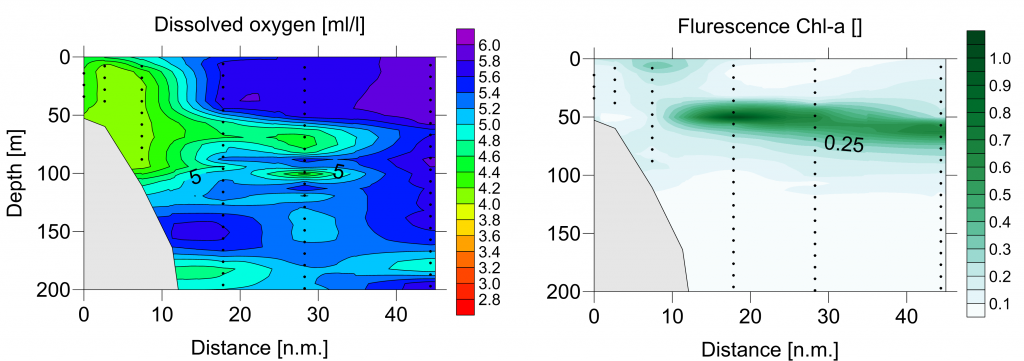
CTD data mirroring the linkage between linkage between oxygen content and phytoplankton abundance as indicated by the chlorophyll (click for larger). (Credit: Jens Weiser)
The geological lab work consisted of opening the cores, making visual core descriptions, preparing smear slides and measuring the colour reflectance. Splitting and describing the cores resulted in a lot of smiling faces, since we did eventually hit the lagoonal muds we missed last week and recovered a lot of other interesting features that probably indicate strong storm events as well as sliding or slumping of material down the slopes of the seafloor topography. On a much smaller scale, the smear slides showed a nice mineralogical link to granites that are found in the hinterland. We could also confirm that the lagoonal deposits are abundant in microfossils, which we will be able to use for paleoenvironmental reconstructions later on!
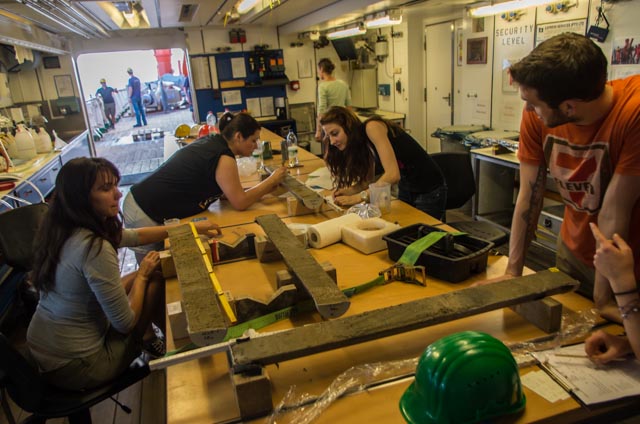
Opening the cores: some say it’s just dirt, others call it Earth history stuck in a barrel. (Credit: Jens Weiser)
Smiling faces were certainly encountered following a few tense moments where we nearly lostour equipment. At the last coring station the wire holding the Vibrocorer snapped, leaving the admittedly not cheap instrument on the seafloor. However, it was still connected to the ship via the electrical cable, so all hope was not lost. We cleared the stage for the ship’s crew and let them work their magic. Lowering a big hook down to the device along the cable, they were indeed able to hook onto the Vibrocorer and lift it back on the ship. So this cruise featured the (probably) first and only successful retrieval of a lost Vibrocorer. Nobody really knows what went wrong or why the wire snapped, but the joy of recovering it soon made the search for reasons obsolete.
To top it all, dinner was a delicious barbecue on deck, live music and sunset over sea included. Sometimes things seem to a have way of working out!

Yesterdays sunset as seen from the top deck, looks just like somebody wanted to reimburse us for the drama of the afternoon… (Credit: Jens Weiser)
By Jens Weiser, University of Bremen
Catch up on previous posts in the series here (setting out for the sea) and here (the hunt for plankton and lagoonal muds).

